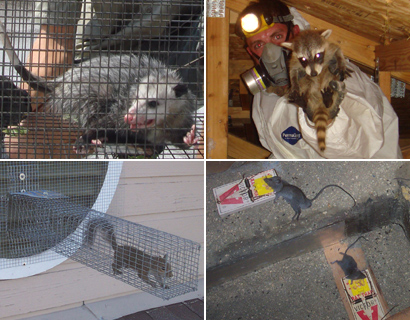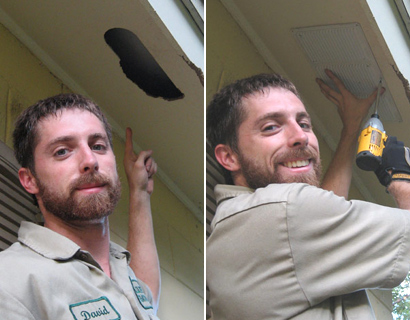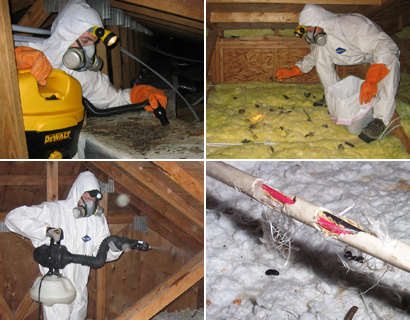- How We Solve Pennsylvania Wildlife Problems
How We Solve Scranton Wildlife Problems
INSPECTION: Once on site, we will perform a full inspection of your home and property. This allows us to use the correct strategy and traps. If the animals are in an attic, a full building inspection is crucial, including the following:
- All ground-level areas, such as piper or A/C line entry & exit areas, A/C chase bottoms, ground-level vents, etc.
- All mid-level areas, such as dryer vents, siding gaps, first floor eaves or dormers, etc.
- We inspect the entire roof, including all plumbing stacks, ridge caps, vents, and other potential gaps or holes.
- We also inspect inside your attic, to identify animals and damage they have caused.
- If the animals are outside, we notice many subtle clues that will assist us in a successful strategy.
TRAPPING, EXCLUSION, REMOVAL: Once we understand what animal species we are dealing with, and the problem, we use the most effective means of removing the animals. We use dozens of different types of traps.
- Trapping - If trapping the animal(s) in live cage traps, trap type, set, and location are crucial to success.
- Exclusion - Oftentimes, we are able to simply set one-way doors or other exclusion devices that allow the animals inside a building to safely exit, but never get back inside.
- Removal By Hand - Sometimes we actually remove animals by hand, or with special tools like snare poles.
- The Law - In all cases, we obey state and local laws regarding wildlife, but aim to take the most humane approach.
ENTRY HOLE REPAIRS: Repairs are a crucial step in the wildlife removal process. In many cases, such as bat or rodent control, the job cannot be performed without detailed repairs, and in all cases, sealing the entry holes shut ensures that no future wildlife will ever enter your home.
- 100% of the entry holes must be found, and sealed shut, or the job is not complete.
- Our repairs are professional contractor grade, look good, and when applicable we use steel, which rodents such as rats or squirrels are unable to chew through.
- We give a written guarantee on our repairs against any future animal entry.
ATTIC DECONTAMINATION SERVICES: It may be desirable to clean your attic after we've removed the animals. They can leave behind large amounts of droppings, urine, hair, oils, food, nesting material, and so on. These remnants can attract insects like cockroaches, and the scent left behind can encourage new animals to chew their way into your house. You might experience odor problems from the waste. It's possible that mold will grow on waste areas.
- We remove or vacuum all droppings, or remove all the soiled insulation.
- We fog the attic with a special enzyme-based cleaner that destroys any organic matter and deodorizes the space.
- We repair damage, such as ductwork, electrical wires, pipes, insulation, and more.
Have you been hearing movement in your walls, but don't know what to do? Give us a call! We have all the answers to your Scranton wildlife needs. There are a few different types of rodents that could be living in your walls if you are hearing movement. Our team is specially trained to deal with these types of issues, plus many more. We service the following cities: Dunmore, Carbondale, Kingston, Wilkes-Barre, Back Mountain, Nanticoke, Hazleton, East Stroudsburg, Berwick, Binghamton, Bloomsburg, Port Jervis, Northampton, Dickson City, Wilkes-Barre, Carbondale, and Hazleton. We also service the following counties: Monroe County, Susquehanna County, Wayne County, Columbia County, Bradford County, Carbon County, Sullivan County, and Schuylkill County.
To learn more about our services, visit the Scranton wildlife control home page.
Other Scranton animal pest control topics:
What To Do if a Bat is in Your Home
What Do Wildlife Rehabilitators Do With Racoons
Should I Ever Poison a Groundhog
What House Mods Will Keeps Pigeons Away
This month's wildlife how-to article: What should I do if I find a nest of baby skunks?
What should I do if I find a nest of baby skunks?
When you discover a nest of baby skunks around your property, the best thing you should do is to contact a wildlife rescue agency around. First of all, baby skunks may be abandoned by their mothers in search of food or a new abode, and that makes the babies subjected to temporary hardship. When a skunk has come out of its mother’s burrow, then it has probably become orphaned, in this case, the baby skunk may try to survive on its own for a while, but you must never make attempts to catch it- if the baby skunk is in danger, then you must wear gloves and a protective clothing and with the aid of a cardboard box, you can move the animal into safety, if you don’t protect yourself, the skunk may release an offensive fluid on you.
The month of May and towards the end of April are usually the period when most baby skunk nests are discovered, and during this period most skunks are active from afternoon and through the night into the early morning hours. You may not discover the nests of baby skunks until they have developed some furs and try to move out on their own to forage. Secondly you may discover baby skunk nests when their mothers have gone out to forage, thus exposing the nests to intruders.
Most people may want to adopt baby skunks after discovering their nests but this is not ideal. First, baby skunks are also capable of releasing the toxic and foul-smelling liquid that skunks release when they are in danger, secondly, some baby skunks are born with transmittable diseases especially when their mothers do have carriers of rabies and some other bacterial and viral diseases in their bodies. For these reasons baby skunks must not be handled with bare hands when their nests has just been discovered, rather, you should call an animal shelter or rehabilitation center immediately.
Do not attempt to feed baby skunks in their nests, though their diet is predominantly made up of insects and some plants, but feeding them human food may make them more susceptible to sicknesses. Likewise, baby skunks should not be offered water when their nests have just been discovered. Even though they may be suffering from dehydration, it may be dangerous to offer them water or food when they are exposed , it is better to carefully get the skunks back to their nests until animal control or rehabilitation officials arrive.





